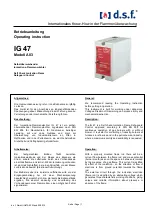
10 – EPRO® SAILOR™ PIPETTES
Dispensing Liquid
3. Place the end of the pipette tip against the inside wall of
the vessel at an angle of 10° to 40°. Press the pushbutton
smoothly to the first stop. Wait one second.
4. Press the pushbutton to the second stop to expel
any remaining liquid. While keeping the pushbutton
depressed, remove the pipette from the vessel by
drawing the pipette tip against the inside surface of
the vessel.
5. Release the pushbutton to its starting position.
6. Eject the pipette tip by pressing the tip ejector
pushbutton.
Remember to change the pipette tip whenever a
different type of liquid is to be sampled.
Aspirating High-density Liquids
When pipetting liquids of higher viscosity or lower surface
tension than water (e.g., sera or organic solvents), a film
of liquid may be formed on the inside of the pipette tip
which may produce erroneous results. As the film remains
relatively constant in successive pipetting operations with
the same tip, this error can be eliminated by pre-rinsing
the tip and allowing a film to form before transferring the
first sample. This is achieved by aspirating a sample and
dispensing it back into the same vessel. Allowing a film
to form prior to sampling ensures optimal accuracy and
repeatability.
This pre-rinsing operation should be repeated when
the volume to be aspirated is changed or when a new
pipette tip is used.
NOTE:
Normally the degree of error resulting from viscous
liquids is negligible if pipetting is performed slowly and
carefully, however can be minimized further by holding
the pipette tip in position for at least 2 seconds after
aspiration to allow the liquid time to react to the change
in pressure before it is dispensed.
If the above method does not result in accurate values,
recalibrate the pipette in accordance with Section 9.
It is recommended to record recalibration and correction
values, in order to facilitate reverse calibration to a standard
liquid.









































